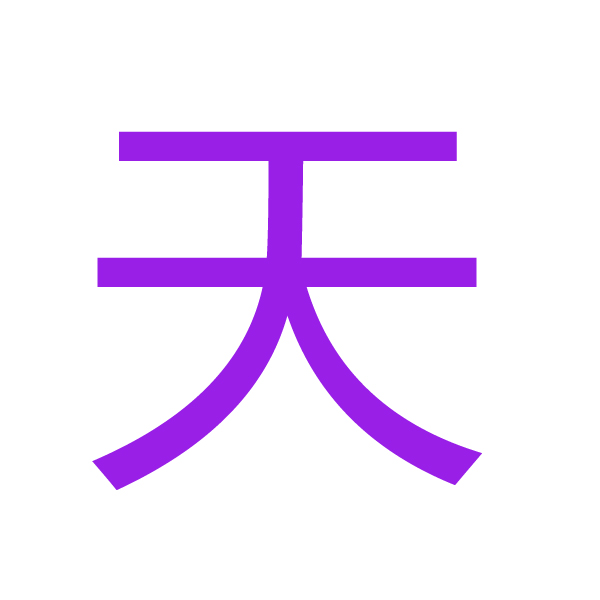
The Kanji: 天 (Ten/Ama) - The "Heaven" Kanji
The kanji "天" is a profound character representing the concepts of "heaven," "the sky," "the heavens," and by extension, "nature," "providence," and "the emperor." It carries both a physical and a deep philosophical/spiritual meaning.
1. Meaning and Usage
Core Meanings: Heaven; sky; providence; nature; the imperial.
Readings:
On'yomi (Chinese reading): テン (ten)
Kun'yomi (Japanese reading): あま (ama-), あめ (ame)
Common Words and Compounds:
天気 (てんき / tenki) - Weather (The "energy" or "spirit" of heaven)
天才 (てんさい / tensai) - Genius (A "heavenly" talent)
天国 (てんごく / tengoku) - Heaven; paradise (The "country of heaven")
天ぷら (てんぷら / tenpura) - Tempura (The word's origin is from Portuguese, but it uses this kanji)
天の川 (あまのがわ / amanogawa) - The Milky Way (The "Heavenly River")
2. Writing and Stroke Order: The Pinnacle of Existence
The correct kanji writing for "天" is simple and powerful. Its stroke order is logical and helps create a balanced, stable character.
Stroke Order:
Stroke 1: A long horizontal stroke from left to right. This represents the vastness of the heavens.
Stroke 2: Another long horizontal stroke, parallel to and below the first. These two top strokes can be seen as representing the firmament or different levels of heaven.
Stroke 3: A left-falling stroke that starts from between the two horizontals and sweeps down to the left.
Stroke 4: A right-falling stroke that starts from the same point as the third stroke, crossing it and sweeping down to the right.
Significance of Correct Kanji Writing:
Balance and Proportion: The two top horizontal strokes should be of good length, with the second one often slightly longer. The two diagonal strokes must be symmetrical and wide enough to create a stable base, preventing the character from looking top-heavy.
A Common Pattern: The bottom part of "天" (strokes 3 & 4) is structurally similar to the kanji 人 (person), which is fitting as the original meaning relates to a "great person."
Foundation: Mastering this character helps with others that have a similar top-heavy structure.
3. Historical Origin and Evolution
The history of "天" is fascinating and reveals a conceptual, rather than purely pictorial, origin.
Oracle Bone Script (甲骨文字):
The earliest form emphasized meaning over pure pictography. It depicted a human figure (人) with an emphasized, large head, or sometimes a line or a dot above the head. The key idea was to represent what was above a person—the great expanse overhead, or the "sky." Some interpretations suggest it represented a "great person" or a "chief," which later elevated to mean the highest power.
Bronze Script (金文) & Seal Script (篆書):
The form became more abstract. The "head" of the human figure was stylized into a straight line, and the overall shape began to resemble the modern form more closely. The connection to a supreme being or the heavens was solidified during this period.
Modern Form (楷書):
The modern "天" is a clean abstraction. The original human figure has been completely stylized. The two top horizontal strokes are the evolution of the emphasized head, and the bottom two strokes are the remnants of the body. The character no longer looks like a person but perfectly symbolizes the abstract concept of "that which is above."
Philosophical and Cultural Connection:
In East Asian thought, "天" is a central concept.
Confucianism: 天 represents the supreme cosmic power, the source of moral law and mandate (天命 - Tenmei, the "Mandate of Heaven").
Shinto and Japanese Culture: It is the realm of the gods (kami). The Japanese emperor was historically considered the "Heavenly Sovereign" (天子 - Tenshi), a descendant of the Sun Goddess Amaterasu.
Nature and Weather: As seen in 天気 (weather), it represents the impersonal, powerful forces of nature that govern our environment.
Summary
The kanji "天" is a character of immense conceptual depth. It began as an ideogram of a person with the sky above them and evolved into the ultimate symbol for heaven, the divine, and the forces of nature. Mastering its stroke order is a fundamental step in Japanese kanji writing, as it is a common character and component. When you learn how to write kanji like "天," you are not just learning a word for "sky"; you are learning a character that encapsulates the highest principles of philosophy, religion, and power in East Asian culture. It is the link between the human world and the divine.